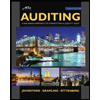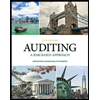
Mylab Accounting With Pearson Etext -- Access Card -- For Auditing And Assurance Services (17th Edition)
17th Edition
ISBN: 9780135176115
Author: Alvin A. Arens, Randal J. Elder, Mark S. Beasley, Chris E. Hogan
Publisher: PEARSON
expand_more
expand_more
format_list_bulleted
Question
Chapter 1, Problem 21DQP
a and b
To determine
Identify the type of auditor and the type of audit for the given items.
Expert Solution & Answer
Want to see the full answer?
Check out a sample textbook solution
Students have asked these similar questions
Peninsula Manufacturing has sales of 1,750,000, costs of 840,000, depreciation expenses of 120,000, and interest expenses of 45,000, with a tax rate of 25 percent. A. Calculate the net income for the firm. B. If the company paid out $115,000 in cash dividends, calculate the increase to retained earnings.
I am looking for help with this general accounting question using proper accounting standards.
Can you explain the correct approach to solve this general accounting question?
Chapter 1 Solutions
Mylab Accounting With Pearson Etext -- Access Card -- For Auditing And Assurance Services (17th Edition)
Ch. 1 - What are the information and established criteria...Ch. 1 - Prob. 2RQCh. 1 - Discuss changes in accounting and business...Ch. 1 - Prob. 4RQCh. 1 - Identify the three main ways information risk can...Ch. 1 - Prob. 6RQCh. 1 - Prob. 7RQCh. 1 - Prob. 8RQCh. 1 - Prob. 9RQCh. 1 - Prob. 10RQ
Ch. 1 - Prob. 11RQCh. 1 - Prob. 12RQCh. 1 - Prob. 13.1MCQCh. 1 - Prob. 13.2MCQCh. 1 - Prob. 13.3MCQCh. 1 - Prob. 14.1MCQCh. 1 - Prob. 14.2MCQCh. 1 - Prob. 14.3MCQCh. 1 - Prob. 15.1MCQCh. 1 - Prob. 15.2MCQCh. 1 - Prob. 15.3MCQCh. 1 - Prob. 16DQPCh. 1 - Prob. 17DQPCh. 1 - Prob. 18DQPCh. 1 - Prob. 19DQPCh. 1 - Prob. 20DQPCh. 1 - Prob. 21DQPCh. 1 - Prob. 22DQPCh. 1 - Prob. 23DQPCh. 1 - As discussed in the chapter opening vignette and...Ch. 1 - Prob. 25DQP
Knowledge Booster
Similar questions
- Aarav Distillers has estimated budgeted costs of $63,000, $74,400, and $85,800 for the manufacture of 3,000, 4,000, and 5,000 liters of wine, respectively, for the next quarter. What are the variable and fixed manufacturing costs in the flexible budget?arrow_forwardThe standard materials cost of WoodWorks' product is $75 per unit, based on 25 pounds of raw materials at a standard cost of $3 per pound. During April 20X9, 1,500 units of product were produced, using 38,500 pounds of raw material at a cost of $3.20 per pound. a) The standard cost for materials for April is . b) The total materials variance for the month is . c) The materials quantity variance is . d) The materials price variance is .arrow_forwardPlease provide the correct answer to this general accounting problem using valid calculations.arrow_forward
arrow_back_ios
SEE MORE QUESTIONS
arrow_forward_ios
Recommended textbooks for you
 Auditing: A Risk Based-Approach to Conducting a Q...AccountingISBN:9781305080577Author:Karla M Johnstone, Audrey A. Gramling, Larry E. RittenbergPublisher:South-Western College Pub
Auditing: A Risk Based-Approach to Conducting a Q...AccountingISBN:9781305080577Author:Karla M Johnstone, Audrey A. Gramling, Larry E. RittenbergPublisher:South-Western College Pub Auditing: A Risk Based-Approach (MindTap Course L...AccountingISBN:9781337619455Author:Karla M Johnstone, Audrey A. Gramling, Larry E. RittenbergPublisher:Cengage LearningPrinciples of Accounting Volume 1AccountingISBN:9781947172685Author:OpenStaxPublisher:OpenStax College
Auditing: A Risk Based-Approach (MindTap Course L...AccountingISBN:9781337619455Author:Karla M Johnstone, Audrey A. Gramling, Larry E. RittenbergPublisher:Cengage LearningPrinciples of Accounting Volume 1AccountingISBN:9781947172685Author:OpenStaxPublisher:OpenStax College

Auditing: A Risk Based-Approach to Conducting a Q...
Accounting
ISBN:9781305080577
Author:Karla M Johnstone, Audrey A. Gramling, Larry E. Rittenberg
Publisher:South-Western College Pub

Auditing: A Risk Based-Approach (MindTap Course L...
Accounting
ISBN:9781337619455
Author:Karla M Johnstone, Audrey A. Gramling, Larry E. Rittenberg
Publisher:Cengage Learning

Principles of Accounting Volume 1
Accounting
ISBN:9781947172685
Author:OpenStax
Publisher:OpenStax College
